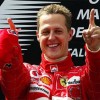Posted 19 May 2012 - 16:51
The CSI convened for their Paris fall conference on Friday, October 11, 1935. The delegates of the various automobile clubs first established the International Sporting Calendar for 1936, next approved Campbell’s records in Salt Lake City and finally settled the European Championship, which was awarded to Caracciola. The CSI drew up the following classification:
1. Caracciola (Mercedes-Benz),………………………… 16 points.
2. Fagioli (Mercedes-Benz), …………………………… ..22 points.
3. Brauchitsch (Mercedes-Benz), ……………………..31 points.
4. Dreyfus (Alfa Romeo), ……………………………..…..35 points.
5. Nuvolari (Alfa Romeo) and Stuck (Auto Union), each 37 points.
7. Chiron (Alfa Romeo) and Varzi (Auto Union), each ...40 points.
On Saturday, October 12th, at the great AIACR banquet staged by the ACF, Rudolf Caracciola ceremoniously was awarded the title “European Champion 1935” in form of a newly created A.I.A.C.R Gold Medal, which represented the highest award in the international automobile sport.
Below follow five different news clippings, which support the statements made in the above paragraph. While these clippings provide very similar information, there were others that differed and one in particular gave a rather bad twist to the official CSI classification, deluding many individuals in understanding the 1935 European Championship. Regarding this awful mess, which exists to this day, we will have to look at later.
AUTOMOBIL-REVUE (Bern), 1935, October 15, No. 83, pg.3
At the conference of the International Sporting Commission (CSI) of the A.I.A.C.R. on last Friday (October 11, 1935) in Paris, the delegates of the various automobile clubs concentrated their main work with the establishment of the International Sporting Calendar for 1936, which temporarily has only provisional character and was submitted for approval yesterday, on Monday, 14th October, to the General Assembly of the A.I.A.C.R., whose decisions were not yet issued at time of going to press. … (This is followed by particulars of the calendar.)
After setting up the International Sporting Calendar, the Sporting Commission (CSI) concerned themselves next with Campbell’s established records in Salt Lake City and approved those. The settlement of the European Championship followed next, which was awarded to Caracciola. The following classification was drawn up:
1. Caracciola (Mercedes-Benz), 16 points.
2. Fagioli (Mercedes-Benz), 22 points.
3. Brauchitsch (Mercedes-Benz), 31 points.
4. Dreyfus (Alfa Romeo), 35 points.
5. Nuvolari (Alfa Romeo) and Stuck (Auto Union), each 37 points.
7. Chiron (Alfa Romeo) and Varzi (Auto Union), each 40 points.
AUTOMOBIL-REVUE (Bern), 1935, October 18, No.84, pg.3
Rudolf Caracciola – European Champion 1935. Mercedes-Benz gained nine victories in the year 1935, including four double and one triple victory in the hardest international races. Rudolf Caracciola was victorious in the six following races: Grand Prix of Tripolis, International Eifelrennen, Grand Prix of France, Grand Prix of Belgium, Grand Prix of Switzerland, Grand Prix of Spain. He came second in the Mercedes-Benz double victory in the Grand Prix of Barcelona and third in the Grand Prix of Germany. With this victory series, R. Caracciola, who already received the title “German Road Champion 1935”, is the most successful driver of the year.
At the great banquet staged by the ACF on Saturday, October 12, Caracciola ceremoniously was awarded the title “European Champion 1935” in form of the A.I.A.C.R Gold Medal. This newly created medal represents the highest award in the international automobile sport.
Allgemeine Automobil-Zeitung (Berlin) No 42, pg 10, October 19, 1935
The most successful driver of the year was Rudolf Caracciola, who became victor in four grands prix. The established order, from the Sporting Committee of the AIACR, of the contestants for the European Championship has the following appearance: Caracciola, Fagioli, v. Brauchitsch, Dreyfus, Stuck, Nuvolari, Varzi, and Chiron, whereby Stuck and Nuvolari as well as Varzi and Chiron each have point equality....(written by Marten)
Speed November-December 1935 p343
"Rudolf Caracciola, member of the Mercedes-Benz team, has been declared champion of Europe, with a total of 16 points. Next in order were his team mates, Fagioli and Von Brauchitsch, with 22 and 31 points, respectively, followed by Dreyfus (35), Nuvolari and Stuck (37 each) and Varzi and Chiron (40 each)"
MOTOR und SPORT No16, pg.27, April 13, 1936
Regulation of the European Championship for cars 1935 In former years different parties occupied themselves to establish ranking lists of race drivers, which in most cases produced an absolutely unclear, even misleading picture, as the events were picked quite at random.
In order to regulate this disorder, the ONS (Oberste Nationale Sportbehörde in Germany) had requested at the last AIACR meeting to determine the European Championship through differing aspects. - The AIACR approved this request at their October 1935 meeting and determined for the first time the European Championship, based on a point scoring system, which awarded the German champion driver Rudolf Caracciola on the basis of his excellent successes with Mercedes-Benz.
For the calculation of the European Championship 1935, the following grands prix are counting:
Grand Prix of Monaco
Grand Prix of France
Grand Prix of Belgium
Grand Prix of Germany
Grand Prix of Switzerland
Grand Prix of Italy
Grand Prix of Spain
For regulating the points score, the following system acts as base:
1. Prize winner in the overall classification 1 point
2. Prize winner in the overall classification 2 points
3. Prize winner in the overall classification 3 points
4. Prize winner in the overall classification 4 points
for the completion of three quarters distance also 4 points
for the completion of half the distance 5 points
for the completion of one quarter the distance 6 points
for the completion of less than one quarter distance 7 points
all drivers which did not start at one of the events 8 points
Hence follows, that the driver with the lowest point score, will be the holder of
the European Championship.
Grand Prix of Caracciola, Fagioli, Brauchitsch, Dreyfus, Stuck, Nuvolari, Varzi, Chiron
Monaco ..…………. 4………….. 1 …………..8 ………………2 ……8 ………….5 ………..8 ………4
France….. ………….1…………… 4 …………..2 ………………7 ……7 ………….7 ………..4 ….….7
Belgium …………….1…………… 2 …………..4……………….4……...8…………. 8 …………8 ……..3
Germany …………..3………….. 4…………… 4………………8 ……..2…………. 1………….4…….. 7
Switzerland ………1 ……………2 …………….5 ……………4 ……..5 …………..4……….. 4 …….7
Italy ………………….5………….. 7……………. 5……………… 2……1…………. 5 …………7 ……..8
Spain…………………1…………… 2……………. 3……………… 8………6…………. 7……….. 5 ………4
TOTAL POINTS….16………….22…………..31……………35…….37…37…40.
.40 ...........



















